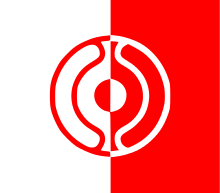Cheondoism
Cheondoism (spelled Chondoism in North Korean sources;[1] Korean: Cheondogyo; hanja 天道教; hangul 천도교; literally "Religion of the Heavenly Way") is a 20th-century Korean religion, based on the 19th-century Donghak religious movement founded by Ch'oe Che-u and codified under Son Pyŏng-Hi.[2] Cheondoism has its origins in the peasant rebellions which arose starting in 1812 during the Joseon dynasty.
| Cheondoism | |
 Cheondoism | |
| Korean name | |
|---|---|
| Hangul | 천도교 |
| Hanja | 天道教 |
| Revised Romanization | Cheondogyo |
| McCune–Reischauer | Ch'ŏndogyo |
 |
| Part of a series on the |
| Culture of Korea |
|---|
| History |
|
Festivals |
|
|
Music and performing arts |
|
Media
|
|
|
Monuments
|
|
National symbols of Korea
|
Cheondoism incorporates elements of Korean shamanism.[3] It places emphasis on personal cultivation and social welfare in the present world and rejects most notions of an afterlife, except for cyclical reincarnation.[2] Splinter movements include Suwunism and Bocheonism.[4]
Name
Cheondogyo translated literally means "religion of the Heavenly Way", where cheon means "Heaven", do means "Way" (written with the same character as Chinese Tao), and gyo means "religion", "teaching", "-ism".
Beliefs
Over time, Cheondoism has also adapted elements of other Korean religious traditions, including Taoism and Buddhism.[5]
In keeping with its roots in Confucian thought, Cheondoism venerates Tian (Heaven) as the ultimate principle of good and justice, which is referred to by the honorific term Haneullim (하늘님), or “Divine Master”. According to the church doctrine, the term "Haneul" does not only mean Heaven but represents the whole universe.[6] This title implies the quality of Heaven as "instructor", that is a belief that man and things are not created by a supernatural (out of nature) God, but generated by a God that is inner in things.[7]
Also in keeping with its Confucian background, Cheondoism places emphasis on personal cultivation in the belief that as one improves one's innate nature, one comes closer to Heaven, and that all things are the same as Heaven in terms of their innate quality.[2]
History
Cheondoism originated from the Donghak ("Eastern Learning"), a religious movement that arose in 19th-century Korea as a reaction to Western encroachment, particularly the spread of Catholicism. The Donghak movement began with Ch'oe Che-u in 1860,[8] but it became an officially-recognized religion under its third leader, Son Byong-hi.[9]
Ch'oe Che-u formulated the Donghak ideology in 1860 as an alternative to Catholicism ("Western Learning"), which was gaining movement with the lower classes in Korea due to its ability to provide a sense of structure and stability beyond the family unit.[8] Due to its basis in established religions—Confucianism, Buddhism, and Taoism—and its commitment to representing Eastern ideals, the movement rapidly gained broad acceptance among the peasantry.[10]
Cheondoism as a religion evolved in the early 1900s from the Donghak peasant liberation movements in the southern provinces of Korea, particularly the unsuccessful, yet consequential, rebellion of 1894. Followers of Donghak were severely persecuted until the establishment of the Protectorate Treaty of 1905, which guaranteed freedom of religion. Therefore, on 1 December 1905, Son Byong-hi decided to modernize the religion and usher in an era of openness and transparency in order to legitimize it in the eyes of the Japanese, who had strong influence over Korea at the time. As a result, he officially changed the name of Donghak to Cheondoism ("religion of the Heavenly Way"). Following this, a constitution and a Central General Bureau were laid out for the religion, centralizing it and making it more accessible to the public.[9]
Cheondoism today
As of 2005, Cheondoism allegedly had about 1.13 million followers and 280 churches in South Korea.[11] Very little is known of the activities of Cheondoists in North Korea. According to official statistics, Cheondoism had 2.8 million adherents in North Korea (12.9% of the total population) as of 2000.[12] Cheondoists are nominally represented in North Korean politics by the minor Cheondoist Chongu Party.
According to the 2015 national census, Cheondoism had about 65,000 followers in South Korea.[13]
References
- "Anniversary of Chondoism Observed, KCNA". Archived from the original on 2014-10-12. Retrieved 2012-06-23.
- Yao, Xinzhong (2000). An Introduction to Confucianism. Cambridge University Press. pp. 121–122. ISBN 0521644305.
- Lee Chi-ran, p.3 & p. 16
- Lee Chi-ran, pp. 16-20
- 韓國 近代宗敎의 三敎融合과 生命·靈性 - 원불교사상연구원 Archived December 25, 2014, at the Wayback Machine
- , 천도교개관(영문)-천도교
- Lee Chi-ran, p. 16
- Young, Carl F. pp.6-7
- Young, Carl F. pp.113-121
- Young, Carl F. pp.10-12
- "Consulate General of the Republic of Korea in Toronto". Archived from the original on 2012-09-07. Retrieved 2012-06-23.
- North Korea
- "2018년 한국의 종교 현황" (in Korean).
This article incorporates text from Korea Web Weekly. Used with permission. Korea Web Weekly is not an independent source of information but is instead associated with various North Korea government sources.
Sources
- Lee Chi-ran. Chief Director, Haedong Younghan Academy. The Emergence of National Religions in Korea.
- Young, Carl F. Associate Professor, Western University. Eastern Learning and the Heavenly Way: The Tonghak and Chondogyo Movements and the Twilight of Korean Independence.